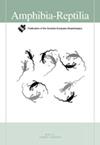The effects of environmental cues on chorusing onset in a tropical frog assemblage
IF 1.3
4区 生物学
Q3 ZOOLOGY
引用次数: 0
Abstract
There are extensive studies on frog calling behaviours, including the effects of environmental variables, however, there are no known studies to explore the specific proximate cues that stimulate the onset of calling in an individual on a given night. The aim of this study is to identify and quantify the species-specific set of environmental variables that stimulate males to produce mating calls under natural conditions. Call surveys were conducted at an active breeding pond on the edge of Parque Nacional Soberanía, Panama, during the breeding seasons of 2009 and 2010. Observations were made on 20 anuran species at the study site and we examined the onset of calling in nine species that were active and most consistently present during breeding seasons. We used logistic and linear regression models to investigate environmental conditions that affect calling for each species. The initiation of chorusing differed by species and key factors included ambient light, rainfall, and lunar cycle. Our data define the margins of a behavioural-environmental envelope that is species-specific and is not related to calling behaviour itself but is rather defined by physiological constraints related to environmental exposure.环境线索对热带蛙群合唱开始的影响
人们对青蛙的叫声行为进行了广泛的研究,包括环境变量的影响,然而,还没有已知的研究来探索在特定夜晚刺激个体发出叫声的特定接近线索。这项研究的目的是识别和量化一组特定物种的环境变量,这些变量刺激雄性在自然条件下发出交配叫声。2009年和2010年繁殖季节,在巴拿马索贝拉尼亚国家公园边缘的一个活跃繁殖池进行了呼叫调查。在研究地点对20个无尾类物种进行了观察,我们检查了9个在繁殖季节最活跃、最稳定的物种的叫声开始。我们使用逻辑和线性回归模型来调查影响每个物种叫声的环境条件。合唱的开始因物种而异,关键因素包括环境光照、降雨和月球周期。我们的数据定义了行为-环境包络的边缘,该包络是特定物种的,与呼叫行为本身无关,而是由与环境暴露相关的生理约束定义的。
本文章由计算机程序翻译,如有差异,请以英文原文为准。
求助全文
约1分钟内获得全文
求助全文
来源期刊

Amphibia-Reptilia
生物-动物学
CiteScore
3.10
自引率
6.20%
发文量
39
审稿时长
6-12 weeks
期刊介绍:
Amphibia-Reptilia is a leading European multi-disciplinary journal devoted to most of the aspects of herpetology: ecology, behaviour, evolution, conservation, physiology, morphology, paleontology, genetics, and systematics.
Amphibia-Reptilia publishes high quality original papers, short-notes, reviews, book reviews and news of the Societas Europaea Herpetologica (SEH). The Societas Europaea Herpteologica (SEH) website is located at: www.seh-herpetology.org.
 求助内容:
求助内容: 应助结果提醒方式:
应助结果提醒方式:


